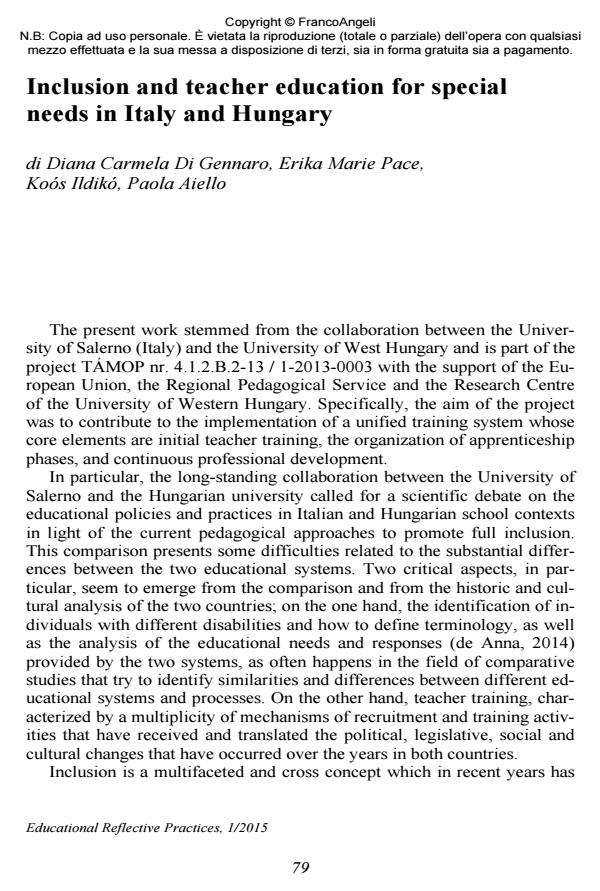Inclusion and teacher education for special needs in Italy and Hungary
Titolo Rivista EDUCATIONAL REFLECTIVE PRACTICES
Autori/Curatori Diana Carmela Di Gennaro, Erika Marie Pace, Koós Ildikó, Paolo Aiello
Anno di pubblicazione 2015 Fascicolo 2015/1 Lingua Inglese
Numero pagine 11 P. 79-89 Dimensione file 86 KB
DOI 10.3280/ERP2015-001006
Il DOI è il codice a barre della proprietà intellettuale: per saperne di più
clicca qui
Qui sotto puoi vedere in anteprima la prima pagina di questo articolo.
Se questo articolo ti interessa, lo puoi acquistare (e scaricare in formato pdf) seguendo le facili indicazioni per acquistare il download credit. Acquista Download Credits per scaricare questo Articolo in formato PDF

FrancoAngeli è membro della Publishers International Linking Association, Inc (PILA)associazione indipendente e non profit per facilitare (attraverso i servizi tecnologici implementati da CrossRef.org) l’accesso degli studiosi ai contenuti digitali nelle pubblicazioni professionali e scientifiche
The present work stemmed from the collaboration between the University of Salerno (Italy) and the University of West Hungary and is part of a project aiming at implementing a unified educational training system whose core elements are initial teacher training, the organization of apprenticeship phases, and continuous professional development. Despite the clear and substantial differences between the school systems of the two countries, the aim that seems to unite the Italian and the Hungarian educational policies is the realization of truly inclusive school contexts within which teacher training takes on a leading role as teachers are the real guarantee that the process of inclusion in the educational and didactic field will be fully realized. With this aim, in both countries there is an ongoing debate about the need of a new teacher professionalism able to face the heterogeneity of today’s school contexts
- Aiello, P. (2012). Italian Ministry Guidelines on SLD Students’ Special Educational Needs. Didactic Suggestions and Teachers’ Training. Szombathely: Savaria University Press.
- De Anna, L. (2014). Pedagogia Speciale. Integrazione e Inclusione. Roma: Carocci.
- Gita, S., Bognar, J., Kalbli, K., & Dorogi, L. (2008). Comparative study on inclusive and special education curricula in Hungary. WYCHOWANIE FIZYCZNE I SPORT, 52(1), 5. DOI: 10.2478/v10030-008-0004-
- Lascioli, A. (2012). Dall’integrazione all’inclusione la scuola che cambia. Orientamenti pedagogici: rivista internazionale di scienze dell’educazione, 59(347), 9-28.
- Ministero dell’Istruzione, dell’Università e della Ricerca, Direttiva Ministeriale 27 dicembre 2012 – Strumenti d’intervento per alunni con Bisogni Educativi Speciali e organizzazione territoriale per l’inclusione scolastica[Intervention tools for pupils with special educational needs and the territorial organisation for school inclusion].
- Ministero dell’Istruzione, dell’Università e della Ricerca, Legge 5 febbraio 1992, n. 104 – Legge-quadro per l’assistenza, l’integrazione sociale e i diritti delle persone handicappate [Law on the assistance, social integration and the rights of handicapped people].
- Ministero dell’Istruzione, dell’Università e della Ricerca, Legge 8 ottobre 2010, n. 170 – Nuove norme in materia di disturbi specifici di apprendimento in ambito scolastico [New norms on Specific Learning Difficulties in schools].
- Ministero dell’Istruzione, dell’Università e della Ricerca, Legge 4 ago sto 1977, n. 517 – Norme sulla valutazione degli alunni e sull’abolizione degli esami di riparazione nonché altre norme di modifica dell’ordinamento scolastico [Norms on the evaluation of pupils and the abolision of remedial exams as well as other amendments regarding the school system].
- Ministero dell’Istruzione, dell’Università e della Ricerca,Decreto Ministeriale 12 luglio 2011, n. 5669 – Disposizioni attuative della Legge 8 ottobre 2010, Nuove norme in materia di disturbi specifici di apprendimento in ambito scolastico[ Implementation provisions of the Law 08/10/2010, New norms on Specific Learning Difficulties in schools; Law 08/10/2010, n. 170 – New norms on Specific Learning Difficulties in schools].
- Ministero dell’Istruzione, dell’Università e della Ricerca,Lineeguida per ildirittoallo studio deglialunni e deglistudenti con disturbispecifici di apprendimento, allegate Decreto Ministeriale 12 luglio 2011, n. 5669 [Guidelines for the right to education of pupils and students with SpecificlearningDifficulties].
- Mittler, P. (2012). Working towards inclusive education: Social contexts. Routledge.
- Peters, S. J. (Ed.). (2013). Education and disability in cross-cultural perspective. Routledge.
- Pető, I. (2013). The Warnock reports and its Hungarian context, in Angyalosi Gergely, MünnichÁkos, Pusztai Gabriella (szerk.) Interdisciplinary Research in Humanities. Nitra: Constantine the Philosopher University in Nitra, Faculty of Central European Studies, 2013. pp. 211-228.
- Sibilio, M. (2013). Una didattica “semplessa” per i Disturbi Specifici dell’Apprendimento (Premessa), in AA.VV. DSA. Elementi di didattica per i bisogni educativi speciali. Milano: Rizzoli.
- Sibilio, M., Aiello, P., Corona, F. (2014). A proposal for a feasible evolution of the role of the support teacher in Italy, Italian Journal of Special Education for Inclusion, anno II, n.2, dicembre 2014, pp.21-34. Tóth, A. N. (2011). Similarities and Differences between systems of pre-primary education in Hungary and Italy, in The teaching of the motor activities in the Italian Maternal School according to the 2007 Guidelines for the Curriculum of the Ministry of Education, edited by Agnes Toth. Ungheria. Savaria University Press.
- Tóth, A. N. (2014). Milestones in the Process of Becoming a Teacher. European Academic Research, Vol. I, Issue 11 / February 2014.
- Tóth, A. N. (2014). Theory and Practice of Inclusive Education in Hungary. Electronic Journal for Inclusive Education, 3(2), 3.
- UN. Convention on the rights of persons with disabilities (2006). New York, NY: United Nations.
- World Health Organisation (Ed.). (2007). International Classification of Functioning, Disability, and Health: Children & Youth Version: ICF-CY. Geneva: World Health Organisation. Retrieved on May 21st, 2014.
Diana Carmela Di Gennaro, Erika Marie Pace, Koós Ildikó, Paolo Aiello, Inclusion and teacher education for special needs in Italy and Hungary in "EDUCATIONAL REFLECTIVE PRACTICES" 1/2015, pp 79-89, DOI: 10.3280/ERP2015-001006